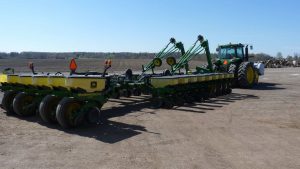A plan to avoid errors
TIPS FROM SPRAYING EXPERTS

A LITTLE PLANNING will go a long way to prevent common errors or issues that farmers experience when it comes to spraying that can result in down time, costly damage to equipment, and damage to crops and other sensitive ecosystems surrounding a field, according to Mike Cowbrough, weed management specialist, and Dr. Jason Deveau, application technology specialist, both with the Ontario Ministry of Agriculture, Food and Rural Affairs (OMAFRA).
Speaking at the SouthWest Agricultural Conference in January, the duo shared some best practices and tips to prevent these issues and mitigate the damage they can cause. The pre-season, says Cowbrough, is the “perfect time of year to evaluate how your pest management plan is going to evolve. Best to do it on a small scale now, figure out what’s best.”
READ THE LABEL
To prevent tank mix errors — and the costly and time-consuming clean-up that can result — Cowbrough says it is best to start with the product label.
“In a perfect world, the product label is the best resource,” says Cowbrough. “Everything is clearly laid out in the product label about how to mix things, what you should do and what you shouldn’t do.”
The challenge with labels is that it can be difficult to find information quickly — the product label on a jug is often upwards of 100 pages long — and it may not even be the most up-to-date product label. Cowbrough recommends looking the product label up on the Pest Management Regulatory Agency (PMRA) website, where product labels are always up-to-date, in PDF format.
Using the search function, he recommends looking for four key words/phrases that will give you the most important information that you need to know about the products you plan to use: Do not mix; hours; agitation; and micronutrients and fertilizers.
For example, using the search term ‘hours’ will tell you when there is a specific risk associated with timing.
“When a label specifies a duration of time, you know it’s important,” says Cowbrough. There may be risks from a health and safety perspective — for example, the label may tell you to stay out of a field for a specific length of time after spraying, or how long a product should be left in the tank.
Cowbrough says that most of the tank mix issues they see are around micronutrients and fertilizers, which makes it an important key phrase to search for. “Some labels are very specific about fertilizers that you can mix, and some very specifically say never mix with any micronutrients or fertilizers.”
And if you can’t find the information you are looking for on the product label, Deveau says it is important to reach out to a technical sales representative or the manufacturer to find out if what you plan to mix is, or isn’t, recommended.
DO A JAR TEST
Before putting any mix in the tank, Cowbrough and Deveau recommend doing a jar test, even if you have been using the same mix for years.
To do a jar test, simply recreate your tank mix, on a smaller scale, in a mason jar, in the same ratios as you would for your sprayer — using the same carrier, the same temperature, the same pH, the same water hardness, in the same order. The results of the jar test will alert you to any potential problems or issues, and can be kept as part of your sprayer records if there are any issues down the road such as crop injury or decreased weed control.
Doing a jar test may be a little daunting for some, says Deveau, “because there is some math involved.” To make it easier, there are off-the-shelf jar test kits that can be purchased.
PREVENTING DRIFT
Drift, or chemical trespass, is an issue that all farmers must think about and plan for. While the applicator has no control over the weather — spraying in high winds is bad, but dead calm even worse — Deveau says that making up for lost time due to adverse weather conditions by driving faster during application is not the best course of action.
“When you drive faster to get more done, generally you have to lift the boom,” says Deveau. “And when you lift the boom, bad things can happen,” including increasing the chance of drift.
Instead of dropping the pedal, Deveau recommends taking some time to build a plan that looks for other efficiencies in the spray program. Application, he says, takes up only about 50 per cent of the time spent on spray days — the rest of the time is spent in other activities such as transporting, mixing, and cleaning the sprayer.
By taking a step back and looking at these other spray-related activities, and then creating a plan to minimize the time spent on them, a farmer can free up more time for application.
RESOURCES AVAILABLE
When it comes to creating a spraying program plan for the upcoming season, Deveau directs growers to a free online resource, www.sprayers101.com. The website is a one stop access point for information on best practices, tips, and research summaries that can help farmers prevent costly and time consuming errors in their spray programs. •



























